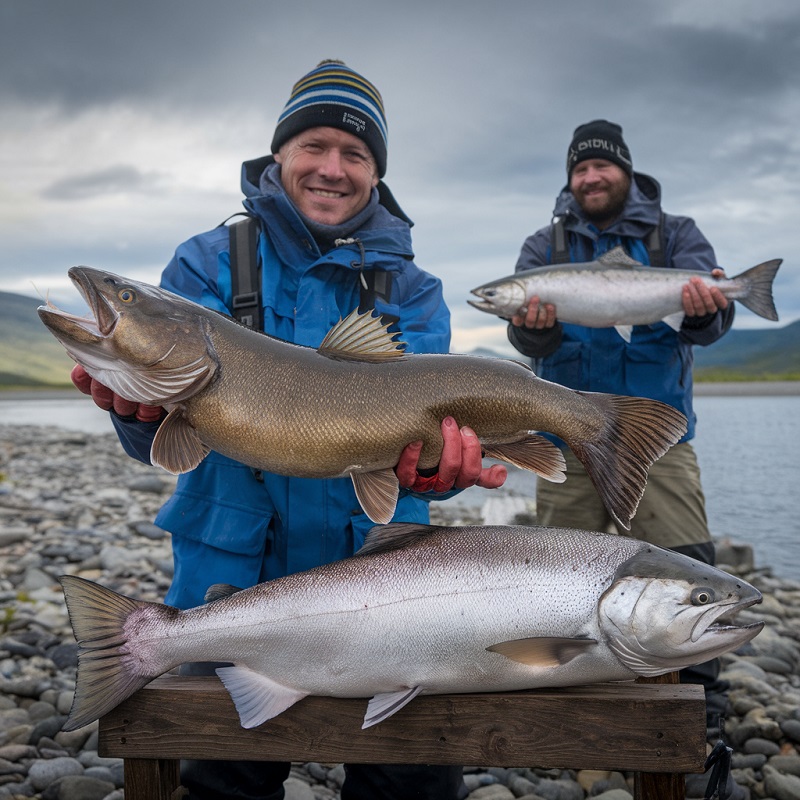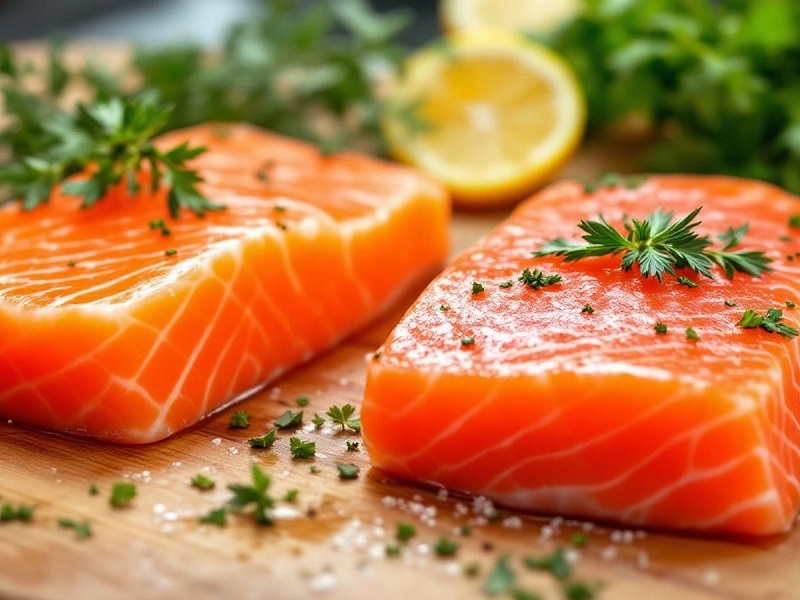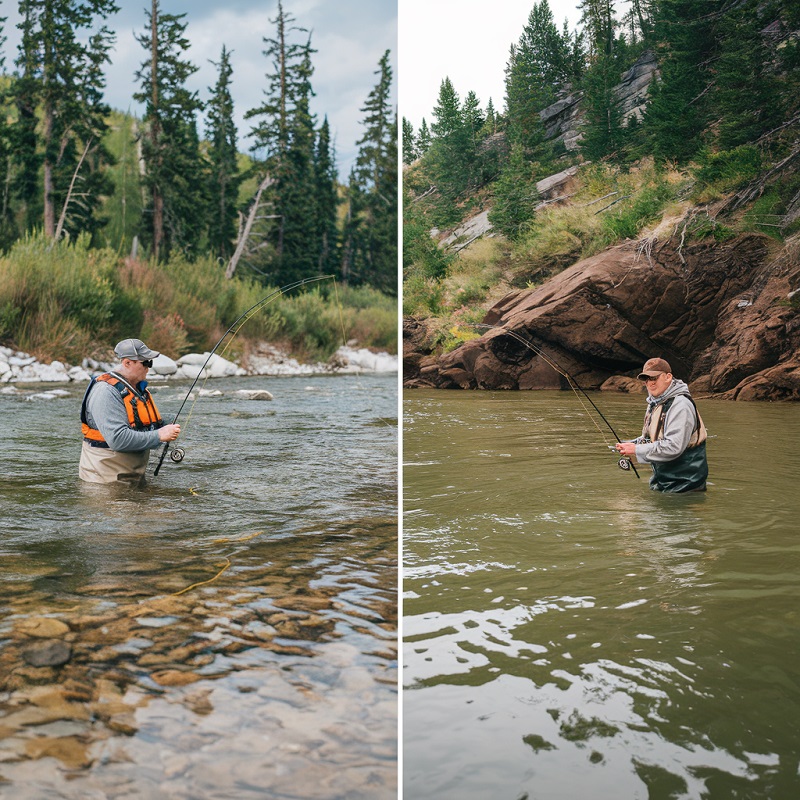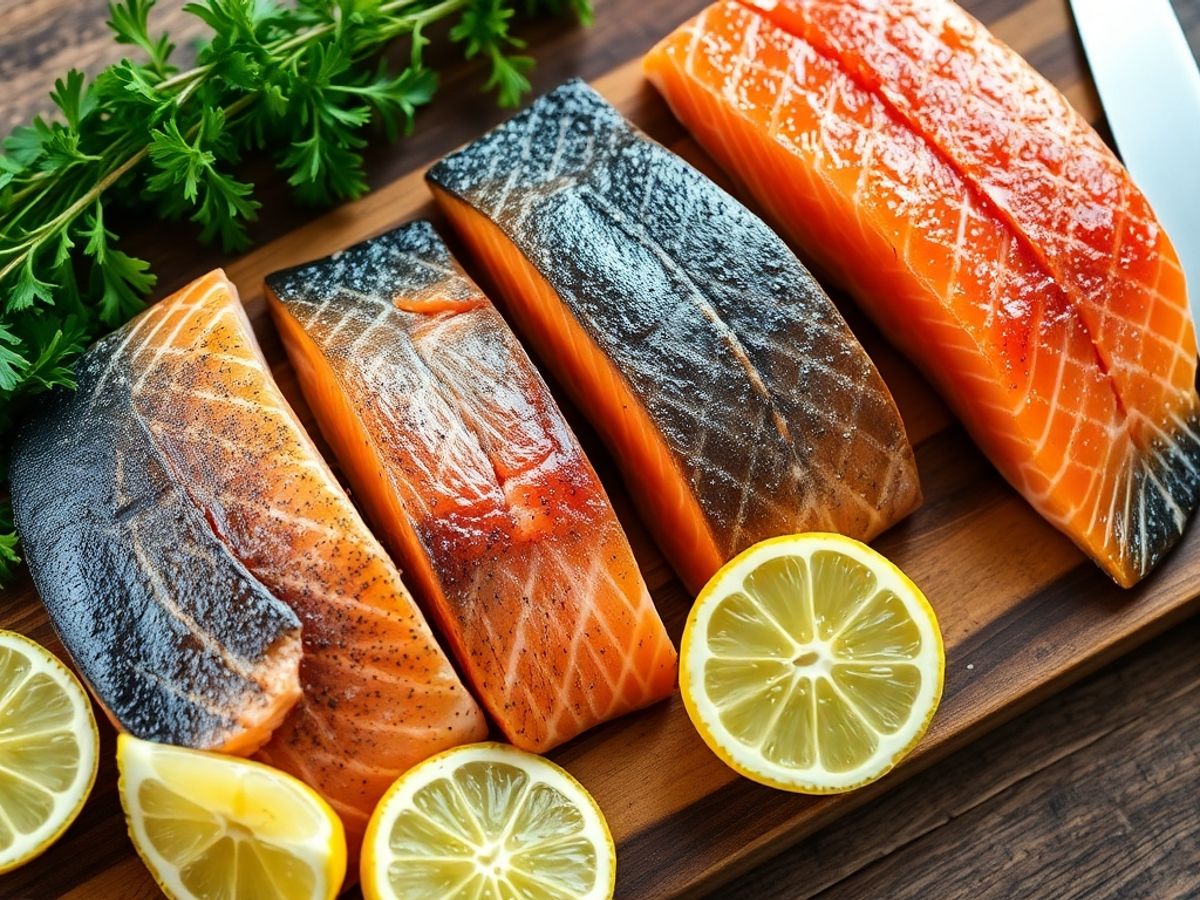Curious about Arctic Char vs Salmon? When it comes to choosing between Arctic Char and Salmon, many people wonder which fish is healthier or tastier. Both fish are popular for their delicious flavors and nutritional benefits, but they have their unique qualities. This article explores their differences in nutrition, taste, cooking methods, and more to help you decide which one is better for you.
Before we get started
What is Arctic Char?
Arctic char is a cold water fish that belongs to the salmon family and is found in northern waters like the Arctic Ocean, lakes and rivers. It has a mild, slightly sweet taste and beautiful reddish orange flesh. It looks like salmon but has some differences.
What is Salmon?
Salmon is one of the most popular fish in the world and is found in both fresh and saltwater. It has a rich flavor and is great for grilling, baking and smoking.
Nutritional Differences Between Arctic Char vs Salmon
Calorie Comparison
When it comes to calories both Arctic char and salmon are similar but there are some differences. Arctic char has slightly fewer calories than salmon so if you’re watching your intake it’s a great choice. A 3-ounce serving of Arctic char has about 150 calories while salmon can range from 180 to 250 calories depending on the type.
Protein in Each Fish
Both fish are good sources of protein which is important for building and repairing tissues. Arctic char has 22 grams of protein per 3-ounce serving while salmon has 23 grams. So if you need a protein boost either fish will do but salmon edges out just a bit.
Omega-3 Fatty Acids: Who Wins?
When it comes to omega-3 fatty acids salmon is the champion. It has more of these heart healthy fats with about 1,500 to 2,000 mg per serving compared to Arctic char’s 1,000 to 1,500 mg. So if you want to boost your omega-3 intake salmon is the way to go. But Arctic char still has some so you won’t miss out if you choose that instead!
Taste and Texture: What to Expect
Flavor Profile of Arctic Char
Arctic char has a milder flavor than salmon, described as delicate and slightly sweet. It’s perfect for those who want a lighter seafood experience. The flesh is firm yet tender and enjoyable to eat. The skin of Arctic char is edible so don’t throw it out! It can be grilled, baked or even smoked which brings out the natural flavors without overpowering them.
Salmon’s Flavor
On the other hand salmon has a rich and robust flavor. Depending on the type like Chinook or Atlantic salmon it can be buttery and oily and has a savory taste that many people love. This richness makes salmon great for grilling or serving raw as sushi. The higher fat content in salmon helps keep it moist during cooking so it’s less likely to dry out.
Texture Differences
Arctic char is firmer than salmon which is softer and more buttery. This affects how each is cooked and eaten. For example both can be grilled or baked but Arctic char holds up well to many cooking methods while salmon is best for quick cooking. Both have unique textures that will make your meal better!
How to Cook Arctic Char and Salmon
Grilling
Grilling is a great way to cook both Arctic char and salmon. The key is to get that skin crispy! For Arctic char leave the skin on as it’s meant to be eaten. A simple trick is to score the skin lightly before grilling which will help it crisp up. Salmon can handle a bit more heat due to its higher fat content so it won’t dry out as easily.
Baking
Baking is another great way to cook both fish. When baking Arctic char keep it simple with some lemon and herbs to enhance its delicate flavor. For salmon you can go bold with spices or even a glaze as its rich flavor can handle stronger flavors. A quick tip: bake at 375°F for 15-20 minutes depending on the thickness of the fillet.
Pan-Seared
Pan-searing is the way to get that golden crust. Start with a hot pan and a little oil. For Arctic char cook skin side down first to get that crispy texture. Don’t forget the skin is meant to be eaten! Salmon can be cooked similarly but you might want to lower the heat a bit to avoid overcooking. Both ways will give you a moist fish that’s hard to resist!
Arctic Char vs Salmon as Fish
When it comes to Arctic Char vs Salmon there are some key differences that make each fish unique. Let’s get into their habitats, looks and more!
Habitat
Both Arctic Char and Salmon can be found in similar environments, often moving between freshwater and saltwater. But Arctic Char are true Arctic fish, they live in much colder waters, even up in the Arctic Circle. Salmon on the other hand prefer slightly warmer waters and are found in places like Alaska and the Great Lakes.
Looks
In terms of looks Arctic Char are beautiful with their shiny silver skin. As they swim upstream to spawn their backs darken and their bellies turn red or orange. Salmon can be colorful too especially during spawning but they usually have darker spots on their body. A quick way to tell them apart is Char have light spots and Salmon have dark ones. Char have a creamy white edge on their fins which is a dead giveaway!
Regions
You can find Arctic Char in cold regions like Northern Canada, Alaska, and parts of Europe, while Salmon are more widespread, with various species found in North America and beyond. So, whether you’re fishing in icy waters or warmer lakes, you’ll know what to look for!
Fishing Techniques: Arctic Char vs Salmon
When it comes to fishing for Arctic char and salmon the techniques used can be different due to their different habitats and behaviors. Arctic char are found in cold freshwater lakes and rivers, mainly in remote northern areas. Anglers targeting Arctic char use fly fishing or light spinning most of the time, especially during summer when char are closer to the surface. Since they are very sensitive to water temperature, small flies, nymphs or even lures that mimic small fish work well. Salmon on the other hand—especially in coastal areas—are caught during spawning runs when they migrate from the ocean to rivers.
Salmon fishing is done trolling in open water or drift fishing in rivers. Since salmon are known for their strength, anglers use heavier tackle, bigger lures and sometimes even live bait to catch these powerful fish. Both are challenging and rewarding in their own ways so the techniques and gear used for each species is specific to their behavior and environment.
Sustainability and Environmental Impact
Fishing Practices
When it comes to sustainability, the way fish are caught or raised matters a lot. Arctic char is often farmed in a way that’s better for the environment compared to many salmon farms. Most char is raised in tanks or raceways on land, which means less pollution and a lower chance of fish escaping into the wild. In contrast, many salmon are farmed in open waters, which can lead to overfishing and environmental issues.
Farmed vs Wild-Caught
Not all salmon is created equal! Wild-caught Pacific salmon is generally considered more sustainable than farmed salmon. However, it can be harder to find and often costs more. If you’re looking for a sustainable option, Arctic char is a great choice because it’s usually farmed responsibly.
Environmental Footprint
The environmental impact of these fish can be quite different. According to the Environmental Defense Fund, farmed salmon has a high environmental risk due to overfishing and poor farming practices. On the other hand, Arctic char is rated much better, making it a smarter choice for eco-conscious eaters.
| Fish Type | Environmental Rating | Notes |
| Arctic Char | Best | Farmed in tanks, low pollution |
| Farmed Salmon | Worst | High risk, often overfished |
| Wild-Caught Salmon | Better | Seasonal availability, more expensive |
Cost and Availability
When it comes to buying fish, price can really vary. Arctic char is often more affordable than wild-caught salmon, making it a great option for those on a budget. For example, in the United States, you might find Arctic char priced around $15 per pound, while wild salmon can go for $25 or more per pound.
Here’s a quick comparison of prices in different regions:
| Region | Arctic Char (USD) | Salmon (USD) |
| United States | $15 | $25 |
| Canada | $14 | $24 |
| Europe | $16 | $26 |
Availability is another factor to consider. Arctic char is usually available year-round, especially if you’re buying farmed fish. On the other hand, wild salmon has specific seasons, which can make it harder to find at times. So, if you’re looking for a mild and delicious fish that won’t break the bank, Arctic char is definitely worth considering!
Popular Recipes to Try
Arctic Char Recipes
If you’re looking to try something new, Arctic char is packed with heart-healthy oils and has a melt-in-your-mouth flavor. One great way to prepare it is by baking it with lemon and herbs. This method keeps the fish moist and enhances its delicate taste. You can also grill it for a smoky flavor that pairs well with a light salad.
Salmon Recipes
Salmon is a classic choice for many home cooks. You can’t go wrong with a simple pan-seared salmon, which keeps the fish juicy and flavorful. For a twist, try marinating it in a mix of soy sauce and honey before grilling. This gives it a sweet and savory kick that’s hard to resist!
Fusion Dishes
Why not mix it up? Try making sushi rolls with both Arctic char and salmon. The combination of the two is a game changer and your friends will love it. Plus you get to eat both fish in one dish!
Cultural Significance and History
Arctic Char in Indigenous Cultures
Arctic char has been a staple in the diet of many Indigenous communities in the Arctic. These fish are not just food they are cultural. They are featured in traditional ceremonies and gatherings. Fishing has been a part of Icelandic culture for centuries showing the deep connection between the people and the environment.
Salmon in Culinary Traditions
Salmon has a rich history in many culinary traditions especially in North America and Asia. It’s celebrated for its flavor and versatility and is featured in special occasion meals and everyday dishes. Many cultures have developed unique recipes that showcase salmon’s robust flavor and it’s a staple in many households.
Historical Consumption Patterns
Both fish have been consumed for their nutritional value. They are high in protein and omega-3’s and have been a part of the diet for centuries. Over time the demand for these fish has grown and so has the fishing and farming of them. Today they are consumed worldwide but their roots in local cultures remain strong a mix of tradition and modern cuisine.
Arctic Char and Salmon Pairing Suggestions
When it comes to pairing suggestions for Arctic char and salmon, there are some great options. Both fish have different flavors that can be paired with various accompaniments. For Arctic char which has a milder taste you might want to try it with a light white wine like Sauvignon Blanc or a refreshing side salad. This fish is perfect for dishes like easy poached arctic char in butter sauce which is quick to make in 30 minutes or less.
Salmon which has a richer flavor pairs well with bolder wines like Pinot Noir or even a zesty lemon sauce. The texture of salmon can hold up to heartier side dishes making it a versatile choice for any meal. Whether you’re grilling, baking or pan searing these pairing suggestions will take your meal to the next level!
Arctic Char vs Salmon FAQs
- Is Arctic char healthier than salmon?
Both are good! Arctic char is leaner but salmon has more omega-3s and vitamin D so they are equal. - Can I use Arctic char instead of salmon in recipes?
Yes, Arctic char can be a great substitute for salmon especially in recipes that call for a milder fish. - Which is more sustainable: Arctic char or salmon?
Arctic char is often more sustainable since it’s land based farmed. But wild caught Pacific salmon is also a good sustainable option. - How do I store Arctic char and salmon?
Both should be stored in the coldest part of the fridge and cooked within 2 days of purchase for best flavor.
5. What’s the best way to cook Arctic char?
Grilled or pan seared






